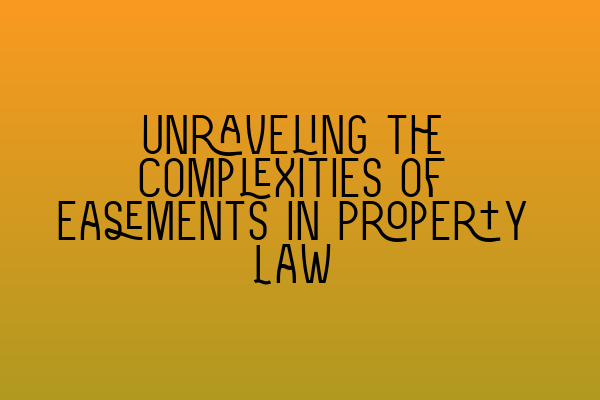Unraveling the Complexities of Easements in Property Law
When it comes to property law, there are various legal concepts that can seem complex and daunting. One such concept is easements. Easements play a crucial role in determining property rights and can significantly affect the use and enjoyment of land. In this article, we will unravel the complexities of easements in property law, providing a clear understanding of their nature, types, and implications.
What are Easements?
In simple terms, an easement is a legal right granted to a person to use another person’s property for a specific purpose. This right is typically non-possessory, meaning the person with the easement does not own the property but has a legal interest in it. Easements can be created for various purposes, such as access to a neighboring property, drainage rights, or the right to install utility lines.
To fully comprehend easements, it’s crucial to understand the three main parties involved:
- Servient Estate: This is the property that is subject to the easement. The owner of the servient estate grants the right of use to the dominant estate.
- Dominant Estate: This is the property that benefits from the easement. The owner of the dominant estate holds the right to use the servient estate for a specific purpose.
- Easement Holder: This is the person who holds the legal right to use the servient estate. The easement holder can be an individual, a business, or a public entity.
Types of Easements
Easements can come in various types, and it’s essential to understand the distinctions between them:
- Appurtenant Easements: Appurtenant easements are attached to the ownership of a specific property, meaning they benefit the property itself. For example, a property owner may have an easement to use a neighboring property’s driveway for access. These easements automatically transfer when the property is sold or transferred.
- In Gross Easements: In gross easements are not tied to the ownership of a particular property, but rather to the individual or entity benefiting from the easement. For example, a utility company may have an easement to install and maintain power lines on a property. In this case, the easement is tied to the utility company, regardless of who owns the property.
- Express Easements: Express easements are created through a written agreement between the parties involved. This agreement, often in the form of a deed or a contract, explicitly outlines the rights and obligations of the parties, including the specific purpose of the easement.
- Implied Easements: Implied easements are not explicitly stated in a written agreement but are implied based on the actions or circumstances of the parties involved. For example, if a property is divided, and one part depends on the other for access, an easement may be implied to ensure reasonable access.
- Prescriptive Easements: Prescriptive easements are acquired through continuous use of another person’s property without permission for a specific period. The use must be open, notorious, and hostile. If the criteria are met, the person using the property can acquire a legal right to continue using it.
Implications of Easements
Easements can have significant implications for both the servient estate owner and the easement holder. It’s crucial to understand these implications before entering into any easement agreement:
- Property Rights: Easements grant certain property rights to the easement holder, allowing them to use the servient estate for a specific purpose. These rights can restrict the servient estate owner’s use and development of the property.
- Maintenance and Repairs: In most cases, the easement holder is responsible for maintaining and repairing the easement area, ensuring that it remains usable for the intended purpose. However, specific arrangements may vary, and it’s essential to clarify these responsibilities in the easement agreement.
- Termination: Easements can be terminated in several ways, including through mutual agreement, abandonment, expiration of a specific time limit, or legal action. Understanding the circumstances under which an easement can be terminated is crucial for both parties.
- Disputes and Litigation: Easements can sometimes lead to disputes between the servient estate owner and the easement holder. These disputes may arise from disagreements over the scope of the easement, the right of access, or the cost of maintenance. In such cases, legal action may be necessary to resolve the issues.
Conclusion
Easements form an integral part of property law and can have a profound impact on the rights and obligations of both property owners and easement holders. Understanding the complexities of easements is essential to ensure a fair and equitable arrangement for all parties involved. If you require assistance with easements or any other property law matters, please feel free to contact us at SQE Property Law & Land Law. Our team of experienced solicitors is here to provide expert guidance and support.
Related Articles:
